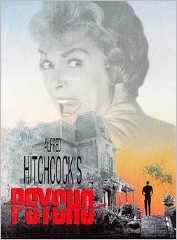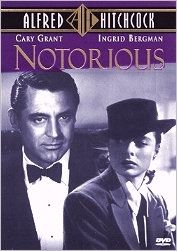 Since he is neither a German expatriate with a penchant for Expressionism nor an idiosyncratic American, Alfred Hitchcock, the most renowned director of thrillers, does not belong to any group prominently associated with noir. Hitchcock, in fact, is seldom labeled as a noir director--certainly he is not linked with the genre to the same degree as Fritz Lang or Robert Siodmak or early Jules Dassin. And yet, as he continued working in that narrow vein of the thriller that he has made distinctly his own, Hitchcock is pre-eminently a noir stylist: Shadow of a Doubt (1943), Notorious (1946), Rope (1948), Strangers on a Train (1951), Rear Window (1954), The Wrong Man (1957), Vertigo (1958), and Psycho (1960), are richly, demonstrably noir.
Since he is neither a German expatriate with a penchant for Expressionism nor an idiosyncratic American, Alfred Hitchcock, the most renowned director of thrillers, does not belong to any group prominently associated with noir. Hitchcock, in fact, is seldom labeled as a noir director--certainly he is not linked with the genre to the same degree as Fritz Lang or Robert Siodmak or early Jules Dassin. And yet, as he continued working in that narrow vein of the thriller that he has made distinctly his own, Hitchcock is pre-eminently a noir stylist: Shadow of a Doubt (1943), Notorious (1946), Rope (1948), Strangers on a Train (1951), Rear Window (1954), The Wrong Man (1957), Vertigo (1958), and Psycho (1960), are richly, demonstrably noir.
Like the traditional noir director, Hitchcock maintains a decided distance from his characters, looking down on them as they become entangled in the nets he carefully spreads. His typical posture is one of amusement--what fools these mortals be--as he masterminds the often catastrophic fates that confound his protagonists. Awful things happen to them--the Hitchcockian world is a series of traps for unsuspecting victims. Like Lang and his compatriots, Hitchcock watches dispassionately, though with more deadpan humor than the Germans could summon, as a terrible pre-ordained destiny overtakes his characters. That same dry humor and unflappable detachment, that same deadly matter-of-factness (part of Hitchcock's familiar persona of a droll, imperturbable Englishman) are present everywhere in the films.
As he manipulates audience involvement, contriving our sympathy for undeserving characters, suggesting our complicity with criminals, Hitchcock himself remains immune, overseeing with Olympian aloofness the dark games he has devised. He resembles the noir director not only in his detachment from the nightmares he depicts but in the absolute control of his work. His autocratic methods are perhaps more well-known than those of any other director. Before filming begins, Hitchcock has planned the film down to the last movement of the camera. There is no "fat" during production, no room for improvisation or spontaneity; everything moves in strick accordance to the direcotr's tight master plan.
 Like many noir directors, Hitchcock often conceives of his films in terms of set-pieces. Sometimes, when he has a weak script, as with Foreign Correspondent, the film consists of practically nothing but a series of sequences intended to display the director's ingenuity. But in all the most successful Hitchcock films there are particular scenes which serve the plot but which also stand on their own, as clever manipulations of film technique that startle the audience. Two of his most fully realized works, Strangers on a Train and Psycho, are ablaze with set-pieces
Like many noir directors, Hitchcock often conceives of his films in terms of set-pieces. Sometimes, when he has a weak script, as with Foreign Correspondent, the film consists of practically nothing but a series of sequences intended to display the director's ingenuity. But in all the most successful Hitchcock films there are particular scenes which serve the plot but which also stand on their own, as clever manipulations of film technique that startle the audience. Two of his most fully realized works, Strangers on a Train and Psycho, are ablaze with set-pieces
In Strangers, memorable high points include a murder reflected through the victim's glasses, Griffith-like cross-cutting between a tennis match and the killer's frantic efforts to retrieve a lighter from a drainpipe, and a merry-go-round that whirls crazily out of control. In Psycho, the brilliantly edited shower scene, an explosion of Eisensteinian montage, the vertiginous angle as Norman Bates carries his mother down to the cellar, the cross-cutting between the sister's search through the Gothic house for Mrs. Bates and the tense confrontation in the motel office between Norman and the murdered victim's fiance. All of these passages involve a rigorous and self-conscious use of editing, camera movement, and camera placement that demonstrates Hitchcock's virtuosity. Just as he controls his actors and his audience, the Master loves to play with film, molding its properties to suit his own ends.
Like all noir directors, Hitchcock is attracted to stories of confinement. After an accident, the photo-journalist in Rear Window is a wheelchair recluse whose only recreation is spying on as much of his neighbors' lives as he can see through the windows on the other side of the courtyard. Rope takes place entirely within an elegant New York penthouse. For this stage-bound drama, Hitchcock devised one of his most ingenious technical solutions, filming the action in a series of long takes, with the few cuts masked by the camera moving in on dark objects that fill the entire frame. Dial M for Murder (1953), another adaptation of a claustrophobic play, is set for the most part in an apartment and in the outside hallway.
 Many of the films take place in an environment that is physically limited. But even in the films that venture beyond confined interiors, the ones set against colorful backgrounds (San Francisco in Vertigo, Morocco in The Man Who Knew Too Much (1956), New York in The Wrong Man, Montreal in I Confess (1952), Washington, D.C. in Strangers on a Train, Rio in Notorious), Hitchcock's canvas is not expansive. The pressure of events forces the characters into hiding. Assailed by the unexpected at every turn, they become paranoid, withdrawn. Even wide-open spaces in Hitchcock are dangerous--in a flat open field in North by Northwest (1959), a plane materializes to attack the dazed hero. And even in the superficial To Catch a Thief (1955), the French Riviera in which the story is set is not a glorious holiday backdrop but a place of lurking threats and potential pitfalls.
Many of the films take place in an environment that is physically limited. But even in the films that venture beyond confined interiors, the ones set against colorful backgrounds (San Francisco in Vertigo, Morocco in The Man Who Knew Too Much (1956), New York in The Wrong Man, Montreal in I Confess (1952), Washington, D.C. in Strangers on a Train, Rio in Notorious), Hitchcock's canvas is not expansive. The pressure of events forces the characters into hiding. Assailed by the unexpected at every turn, they become paranoid, withdrawn. Even wide-open spaces in Hitchcock are dangerous--in a flat open field in North by Northwest (1959), a plane materializes to attack the dazed hero. And even in the superficial To Catch a Thief (1955), the French Riviera in which the story is set is not a glorious holiday backdrop but a place of lurking threats and potential pitfalls.
Hitchcock's camera choreography is more complex than the tight, static set-ups typical of noir. There are virtuoso displays of camera movement throughout the canon: the camera encircling the lovers in Vertigo; the camera retreating down the stairs and away from the scene of a murder in Frenzy (1972); the gliding, roving camera in Rope, its movement breaking up the static space in which the action unfolds. But the utter calculation of the movement prevents it from having an open, liquid quality, a fluency that would be foreign to noir. Even when he indulges in movement that is seemingly sweeping and expnsive, Hitchcock's work is taut, intentionally mechanical.
--FOSTER HIRSCH, from Film Noir
The Dark Side of the Screen.